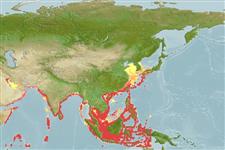>
Scombriformes (Mackerels) >
Trichiuridae (Cutlassfishes) > Lepidopodinae
Etymology: Eupleurogrammus: Greek, eu = good + Greek, pleura = near, on the side + Greek, gramma = mark, signal (Ref. 45335).
More on author: Gray.
Environment: milieu / climate zone / depth range / distribution range
Ecologia
marinhas; estuarina bentopelágico; intervalo de profundidade 0 - 80 m (Ref. 6181). Tropical; 41°N - 11°S, 47°E - 135°E (Ref. 6181)
Indo-West Pacific: including the Persian Gulf, India, Sri Lanka, Malaysia, Indonesia, Gulf of Thailand, China and southern Korean Peninsula.
Tamanho / Peso / Idade
Maturity: Lm ? range ? - ? cm
Max length : 87.0 cm TL macho/indeterminado; (Ref. 112044); 97.5 cm (female); common length : 50.0 cm TL macho/indeterminado; (Ref. 9688)
Espinhos dorsais (total) : 3; Raios dorsais moles (total) : 140. Body extremely elongate, compressed and tapering to a point. Anal fin reduced to minute spinules buried in skin; caudal fin absent; pelvic fins present but reduced to a scale-like process. Lateral line running almost straight along midbody or slightly nearer the ventral contour. Color of fresh specimens steely blue with metallic reflections, becoming silvery gray after death.
Inhabits coastal waters and often comes near the surface at night. Enters estuaries (Ref. 1479). Feeds on a wide variety of small fishes, squids and crustaceans. Marketed mainly in dried and salted forms (sometimes fresh), mixed with other trichiurids. Caught mainly with shore seines, bag nets and coastal bottom trawls in coastal waters down to about 50 m in West Bengal to Madras and around Bombay of India.
Life cycle and mating behavior
Maturidade | Reprodução | Desova | Ovos | Fecundidade | Larvas
Nakamura, I. and N.V. Parin, 1993. FAO Species Catalogue. Vol. 15. Snake mackerels and cutlassfishes of the world (families Gempylidae and Trichiuridae). An annotated and illustrated catalogue of the snake mackerels, snoeks, escolars, gemfishes, sackfishes, domine, oilfish, cutlassfishes,. scabbardfishes, hairtails, and frostfishes known to date. FAO Fish. Synop. 125(15):136 p. (Ref. 6181)
Categoria na Lista Vermelha da IUCN (Ref. 130435: Version 2024-1)
Ameaça para o homem
Harmless
Utilização humana
Pescarias: espécies comerciais
Ferramentas
Relatórios especiais
Descarregue XML
Fontes da internet
Estimates based on models
Preferred temperature (Ref.
123201): 24.3 - 29.1, mean 28.4 °C (based on 1170 cells).
Phylogenetic diversity index (Ref.
82804): PD
50 = 0.7500 [Uniqueness, from 0.5 = low to 2.0 = high].
Bayesian length-weight: a=0.00033 (0.00020 - 0.00054), b=3.20 (3.06 - 3.34), in cm total length, based on LWR estimates for this species & (Sub)family-body (Ref.
93245).
Nível Trófico (Ref.
69278): 4.1 ±0.7 se; based on diet studies.
Resiliência (Ref.
120179): Elevada, tempo mínimo de duplicação da população menor que 15 meses (Preliminary K or Fecundity.).
Fishing Vulnerability (Ref.
59153): Moderate to high vulnerability (48 of 100).
Nutrients (Ref.
124155): Calcium = 96.2 [48.9, 173.9] mg/100g; Iron = 0.923 [0.467, 1.688] mg/100g; Protein = 17.8 [16.3, 19.4] %; Omega3 = 0.162 [0.081, 0.352] g/100g; Selenium = 85.5 [42.2, 182.5] μg/100g; VitaminA = 17.8 [5.0, 50.9] μg/100g; Zinc = 0.981 [0.667, 1.547] mg/100g (wet weight);
